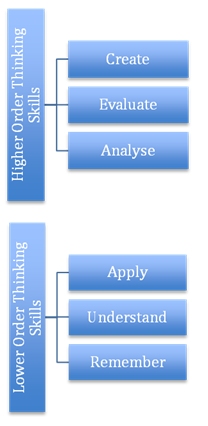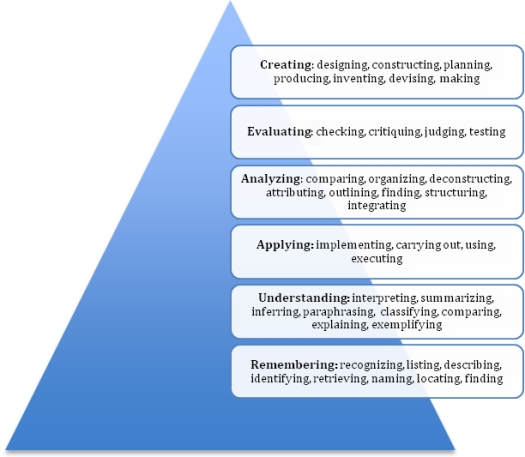EFL Classrooms Can Teach Higher Order Thinking Skills
Percival Santos, PRC
Percival Santos (PhD, London School of Economics) was Assistant Professor at the Center for Academic English Studies, Dongbei University of Finance and Economics, Dalian, China. He currently teaches sociology at the Rainham School for Girls in Gillingham, Kent, UK. He has published on academic writing and CLIL. E-mail: fieldwork38@yahoo.co.uk
Menu
Introduction
Background
Examples
Conclusions
References
Most EFL teachers now take for granted that their lessons should promote communicative and intercultural competence to some degree. But should they have the enhancement of thinking skills as an additional aim? This article will argue that cognitive development in the EFL classroom is not only a worthwhile goal in itself, as it helps to create a much better prepared citizenry that is able to participate in a meaningful way in a country’s democratic life, but that it also improves students’ English language proficiency. It will briefly talk about talk about two important ways that thinking skills have been researched in the literature. It will concentrate on the latter one and give ideas on how it can be integrated in the second language classroom.
There are many ways of conceptualizing the process of thinking. One common way is through the term Critical Thinking (CT). Although many agree the importance of CT, there are a diversity of opinions regarding what the concept is. For some, its characteristics are assessment of evidence, critical appraisal, reflection, understanding, analysis, synthesis, and evaluation. Others emphasize the objective to subjective process and the necessity of providing supporting evidence. Many argue that it is a form of reasonable, reflective thinking, focused on deciding on what to believe or do. From these examples we can see that CT is a broad term for which no common definition exists.
Another concept in the area of thinking skills is the notion of higher order thinking skills (HOTS). This involves conceptualizing the different forms of thinking as belonging to a hierarchy wherein more cognitively complex thoughts occupy a higher and more valuable place than cognitively simpler ones. These forms of thinking may be seen as domains with progressively higher degrees of difficulty, wherein the lower one must normally be mastered before the next one can take place. This hierarchy of thinking skills is often referred to as a taxonomy and Bloom’s Taxonomy is probably the most well-known of all. Bloom’s original taxonomy was formulated in 1956 and cognitive skills such as analysis, evaluation and synthesis were thought to be of a higher order than the rote learning of facts and concepts. HOTS are regarded as more valuable than simple memorization, understanding and application, also known as lower order thinking skills (LOTS). Many later educationalists have tried to revise Bloom’s original taxonomy, the most significant revision being Anderson, & Krathwohl’s (2001) Revised Bloom’s Taxonomy (RBT) below (Figure 1):
Figure 1: Revised Bloom’s Taxonomy

Each level of the RBT is associated with certain cognitive action words (Figure 2):
Figure 2: Verbs Associated with RBT

Is there any evidence that teaching thinking improves English language learning? Research has shown that cognitive and linguistic development, are closely related. Educators have long recognized that language and thinking skills were closely intertwined. Some believed that higher-order thinking skills promoted higher order learning skills. And the development of these advanced learning skills were closely related to the acquisition of high levels of language proficiency
Researchers have attempted to integrate thinking and language skills in the language curricula. There exists ample literature (Staton, 1984; Pearson & Tierney, 1984; Stanford & Roark, 1974; Moffett & Wagner, 1983) which documents efforts made by English as a Second Language (ESL), English as a Foreign Language (EFL), and Modern Foreign Language (MFL) educators in their attempts to promote both language learning and cognitive development. Similarly, educators have also called for the teaching of higher-order thinking skills in ESL and EFL classrooms. Students are more likely to recall facts and concepts that originated from a cognitively more challenging lesson than they are from a less-challenging one.
Moreover, integrating thinking skills in the foreign language classroom significantly raises language proficiency. In an experimental study designed to test the effect of CT-enhanced activities in the language classroom, an EFL class was divided into two groups, one with CT-enhanced teaching and the other with non CT-enhanced teaching. The study shows (Yang & Gamble, 2013, p. 398):
While Experimental group learners engaged in CT-enhanced activities such as debates and peer critiques, Control group learners engaged in non CT-enhanced EFL activities such as group presentations and process writing, effective but without an emphasis on CT. Experimental group learners demonstrated a significant improvement in English proficiency in comparison to the Control group. Furthermore, superior CT and academic achievement were observed for the Experimental group in a content-based exam.
How can teachers integrate thinking skills into the foreign language classroom? Although CT and RBT are both valid ways of ‘thinking about thinking’, from a methodological standpoint the RBT facilitates the design of learning tasks with greater ease than CT. This is due to four reasons. First, the RBT provides a universally agreed definition regarding what it means to ‘think’. Second, as the six cognitive domains are clearly defined (applying, analyzing) one can easily identify how cognitively challenging any given task is, that is, one can easily say whether a task develops LOTS or HOTS. Third, as these domains are associated with action words, teachers can ensure that their task will be at the desired level of cognitive development as long as its principal activity contains at least one of the associated action verbs. Last, teachers can design a series of tasks, the earlier ones being less challenging and the later ones more so, by working their way up the taxonomy. Have a look at the table below as an example of how RBT can be applied to a series of learning activities centered around one theme or story (Table 1):
Table 1: Using RBT to Teach Goldilocks
| RBT |
Domain |
Task |
| Higher Order Thinking Skills |
Create |
Compose a song, skit, poem, or rap song to convey the Goldilocks story in a new form. |
| Evaluate |
Judge whether or not you think this really happened to Goldilocks. |
| Analyze |
Compare how Goldilocks reacted and how you would react in each story event. |
| Lower Order Thinking Skills |
Apply |
Do a roleplay based on the story of Goldilocks |
| Understand |
Summarize what the Goldilocks story was about. |
| Remember |
Describe where Goldilocks lived. |
Dialogue and interaction in the classroom- between teacher and learners and between learners is at the core of learning. And the RBT can be an excellent way to structure a dialogue-centered lesson. Dialogic forms of teaching are potent tools for securing learner engagement, learning and understanding. Dialogic teaching can be an extremely effective instrument for encouraging cognitive and language development as it offers EFL students the following benefits:
- they receive comprehensible input and produce comprehensible output
- they learn appropriate social and communicative strategies
- they are exposed to alternative perspectives on different topics
The table below (Table 2) illustrates how teachers can start the lesson by asking factual questions, which are the least challenging and only involve recall and retrieval of knowledge and later on ask more cognitively challenging questions:
Table 2: Using RBT for Dialogic Teaching
| Thinking Skill |
Questions |
| Create |
Can you design a...to...?
How many ways can you...?
Can you develop a new way to…?
|
| Evaluate |
Do you think...is a good or bad thing?
Can you tell me how effective/useful this is?
How would you improve it?
|
| Analyze |
What are their similarities and differences?
Can you group/classify these activities according to gender?
|
| Apply |
Can you do apply the example to some experience in your own life? |
| Understand |
Can you define…? |
| Remember |
What is…..?
Who is…..?
How many…?
|
To sum up, EFL teachers can incorporate the teaching of thinking skills because students will not only become better thinkers, but also better language learners. Although CT and RBT are useful ways of ‘thinking about thinking’ the RBT offers a much easier platform or template for designing learning activities. The RBT can be applied to a series of learning activities centered around one theme or story or it can be used to structure a dialogic question-centered lesson.
Anderson, L. W. & Krathwohl, D. R. (2001). A taxonomy for learning, teaching, and assessing: A revision of Bloom's taxonomy of educational objectives. New York, USA: Addison-Wesley Longman.
Moffett, J., & Wagner, B. J. (1983). Student-centered language arts and reading: A handbook for teachers. Boston, Massachusetts: Houghton Mifflin.
Pearson, P. D., & Tierney, R. (1984). On becoming a thoughtful reader: Learning to read like a writer. In A. Purves, & O. Niles (Eds.), Becoming readers in a complex society (pp.144-173). Chicago: University of Chicago Press.
Stanford, G., & Roark, A. (1974). Human interaction in education. Boston, Massachusetts: Allyn and Bacon.
Staton, J. (1984). Thinking together: Language interaction in children’s reasoning. In C. Thaiss, & C. Suhor (Eds.), Speaking and writing, K-12: Classroom strategies and the new research (pp.144-187). Urbana, Illinois: National Council of Teachers of English.
Yang, Y.T.C, & Gamble, J. (2013). Effective and practical critical thinking-enhanced EFL instruction. ELT Journal, 67(4), 398-412.

Please check the Methodology & Language for Secondary Teachers course at Pilgrims website.
Please check the Teaching Advanced Students course at Pilgrims website.
Please check the English Language Improvement for Teachers course at Pilgrims website.
Please check the English Language Improvement for Adults course at Pilgrims website.
Please check the Creative Methodology for the Classroom course at Pilgrims website.


|